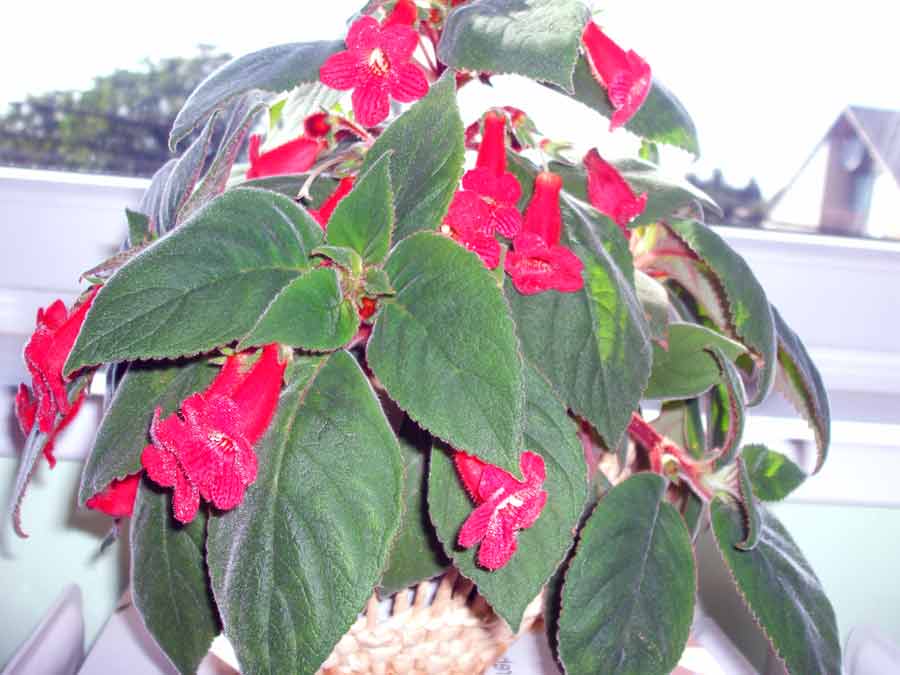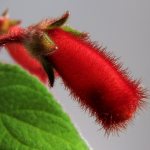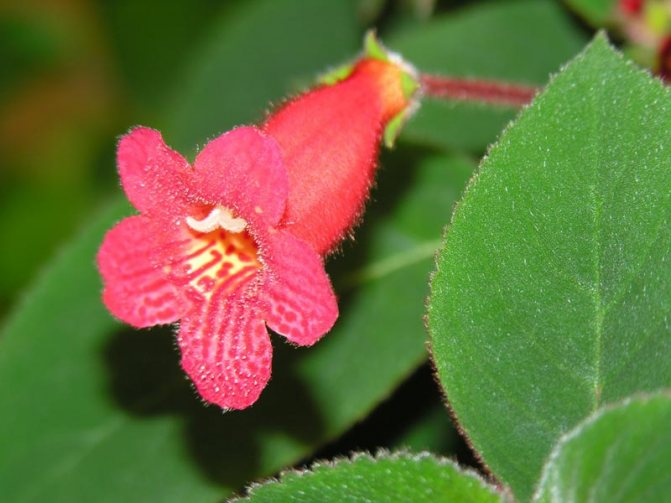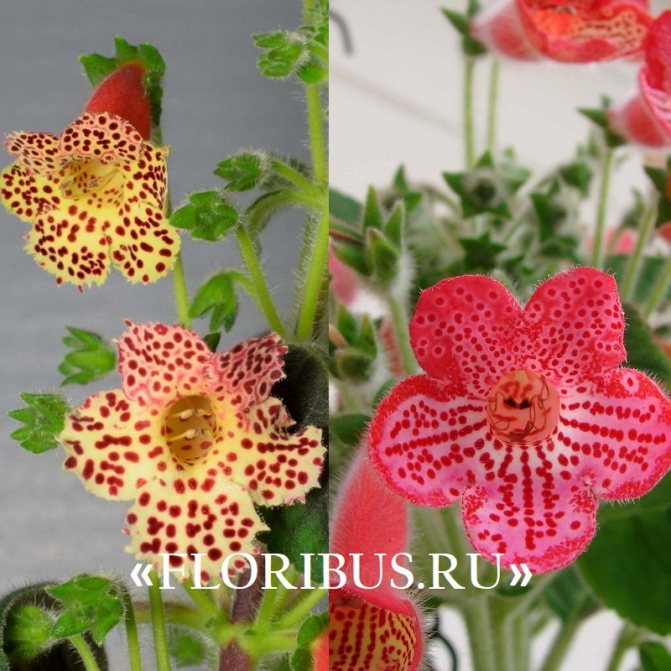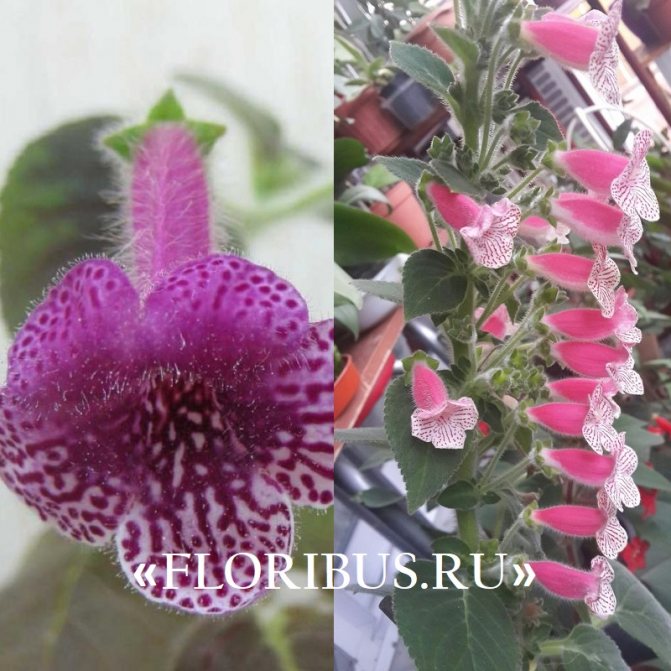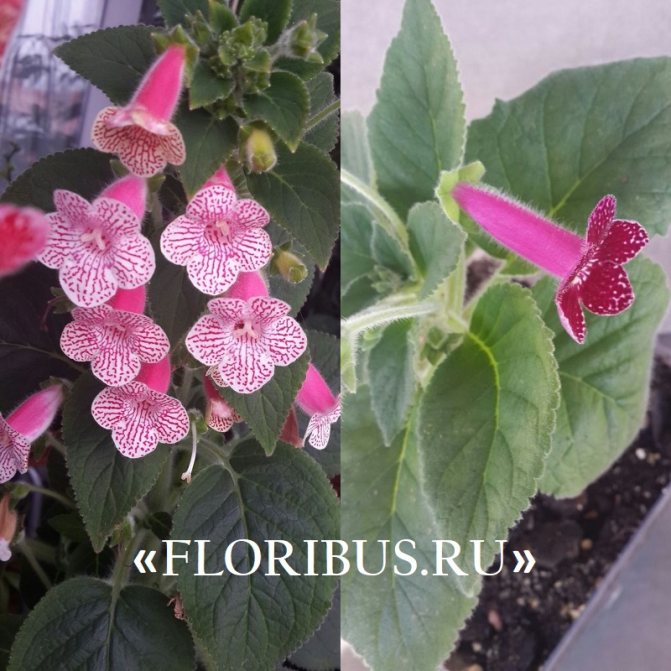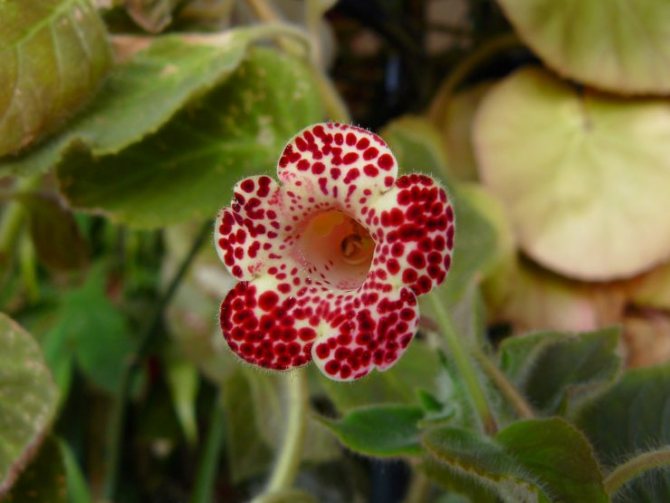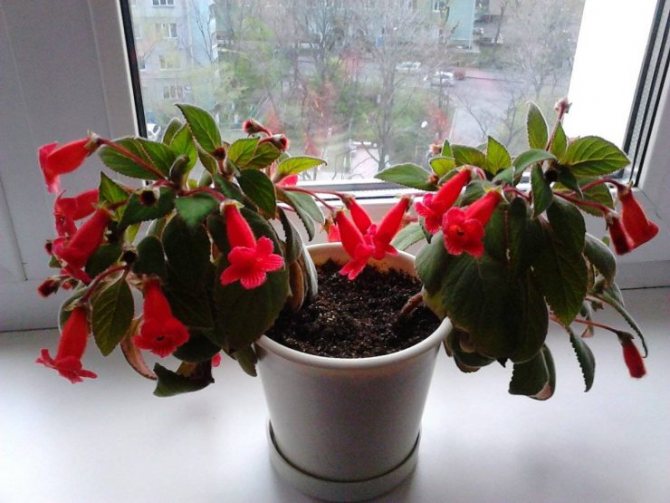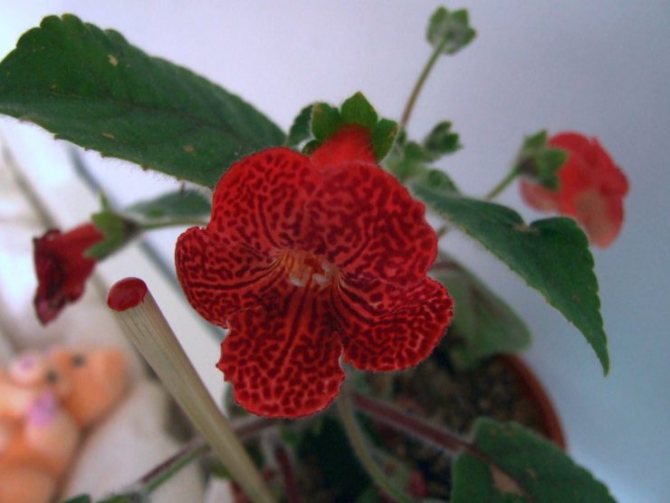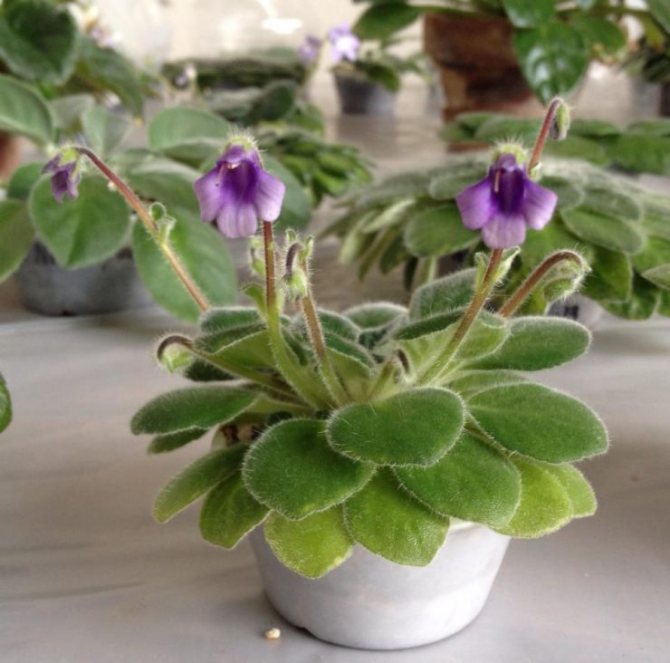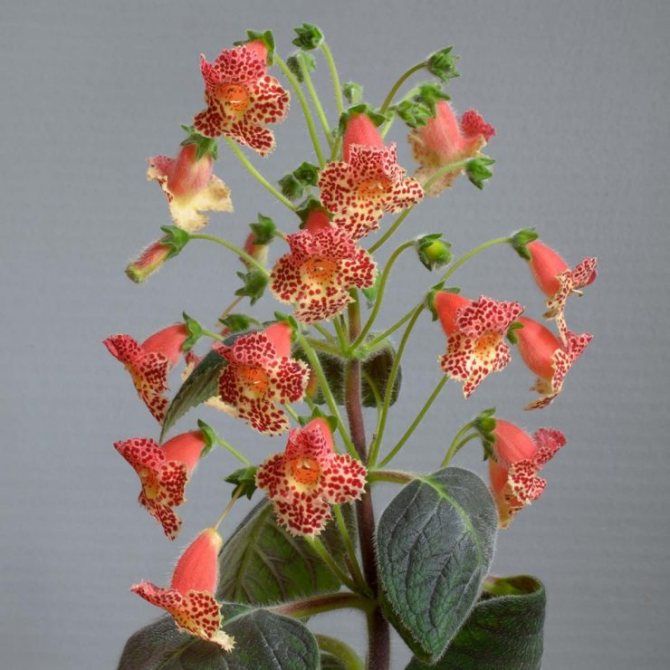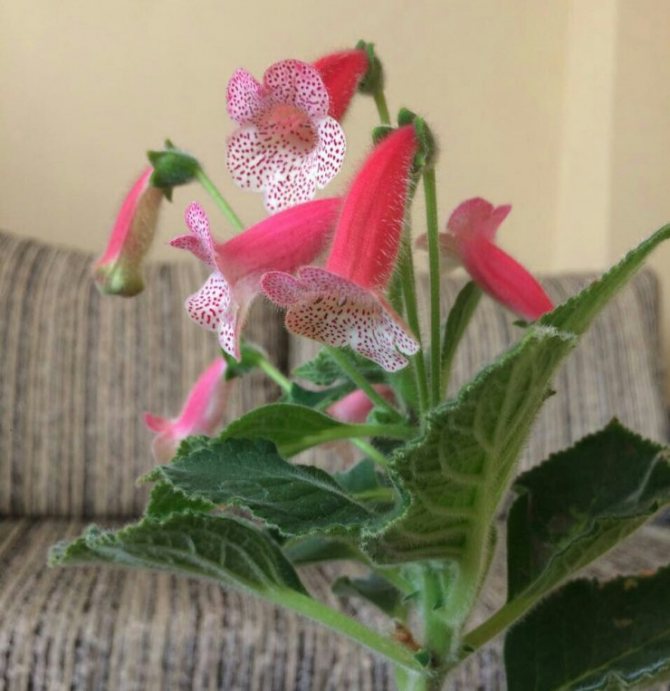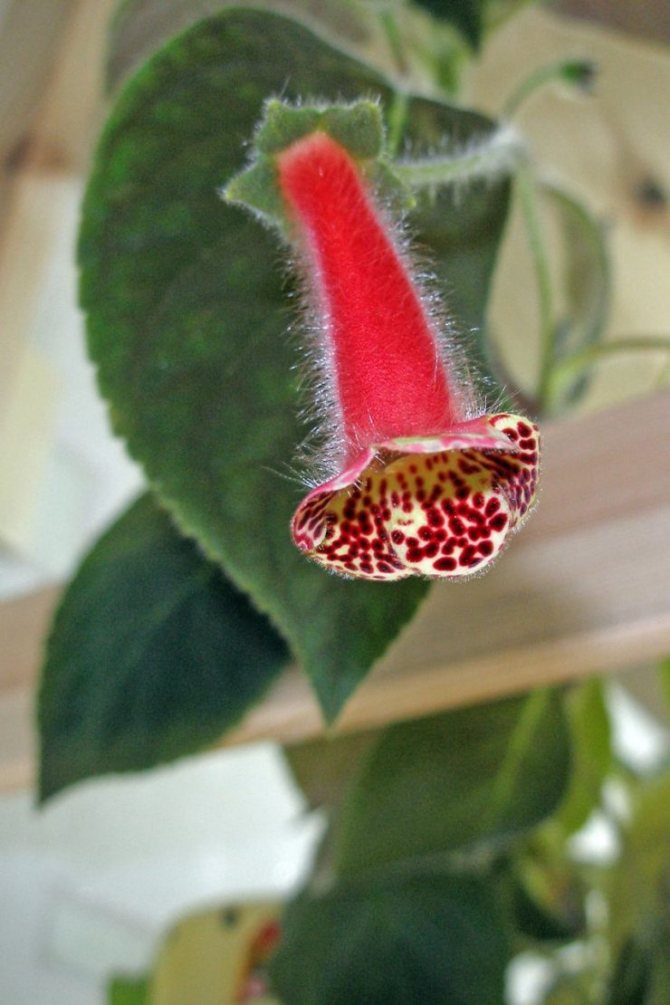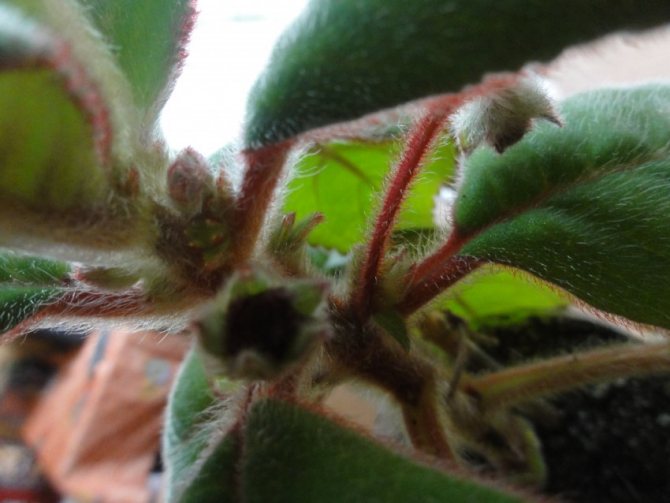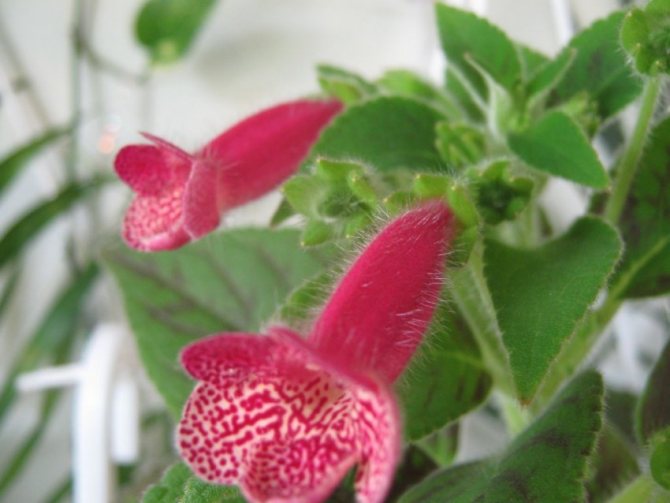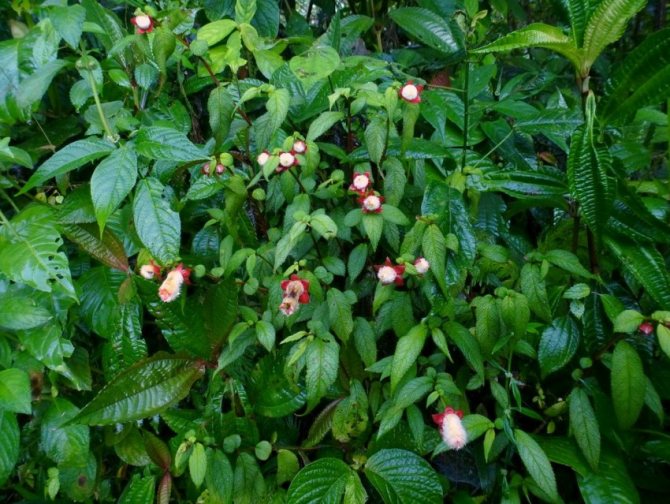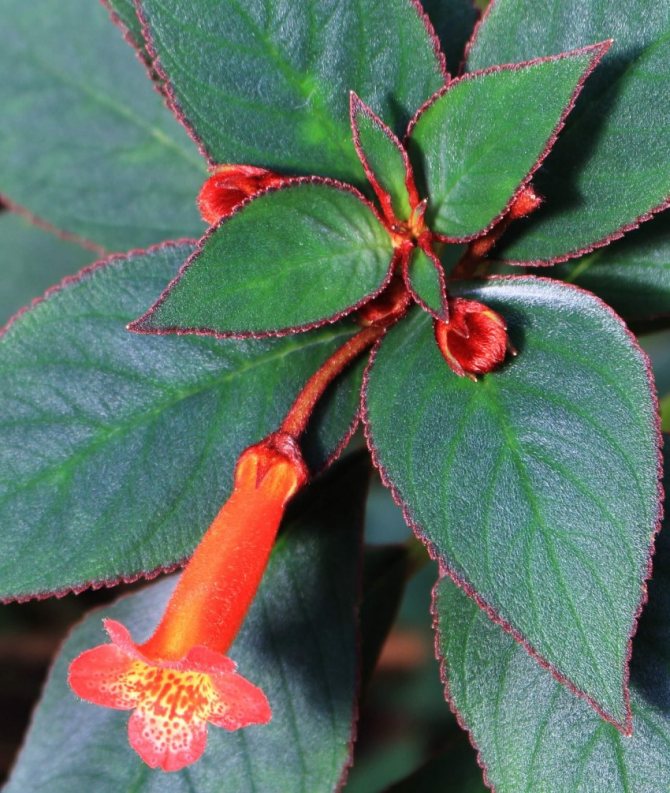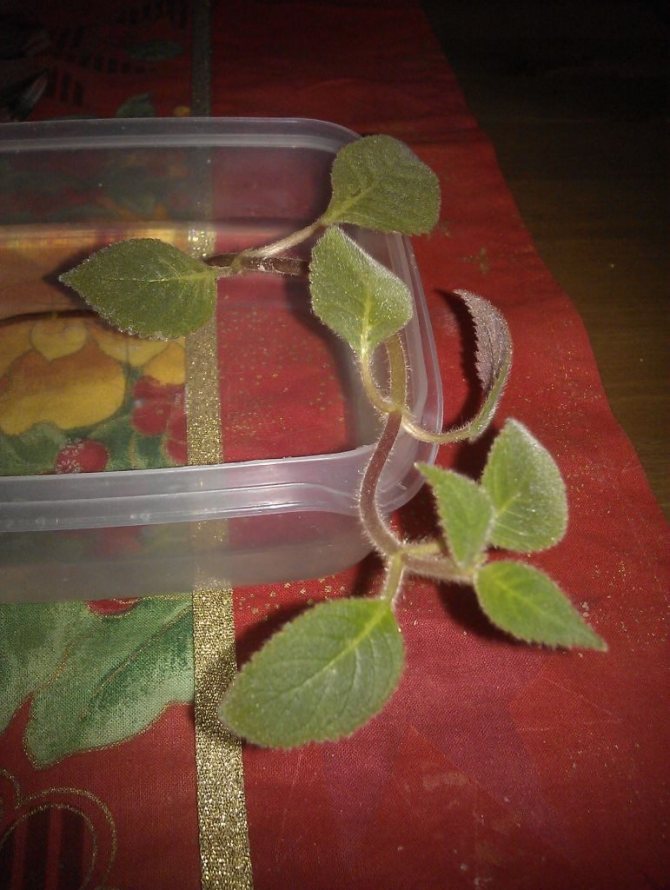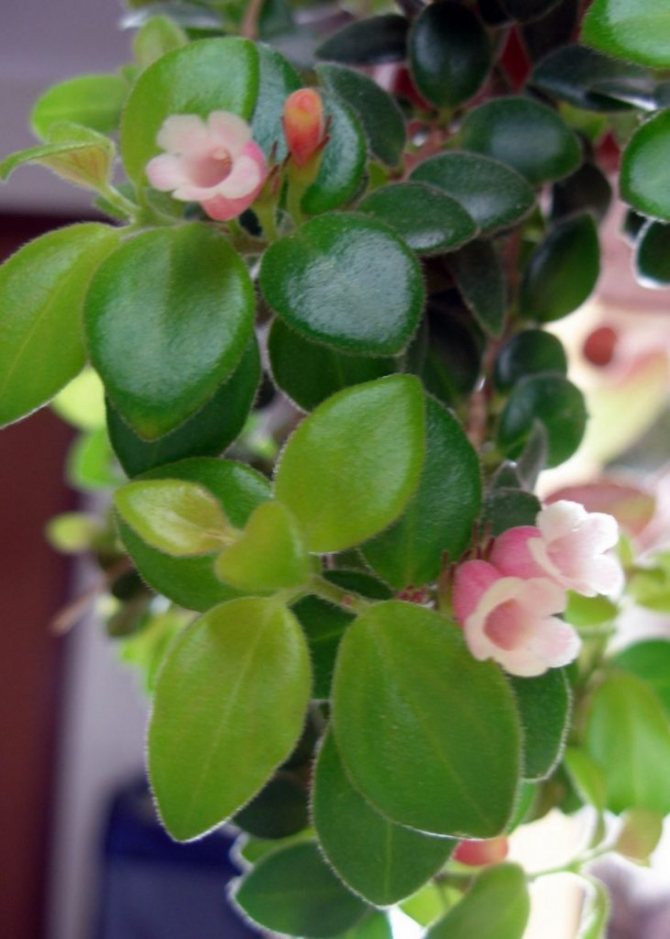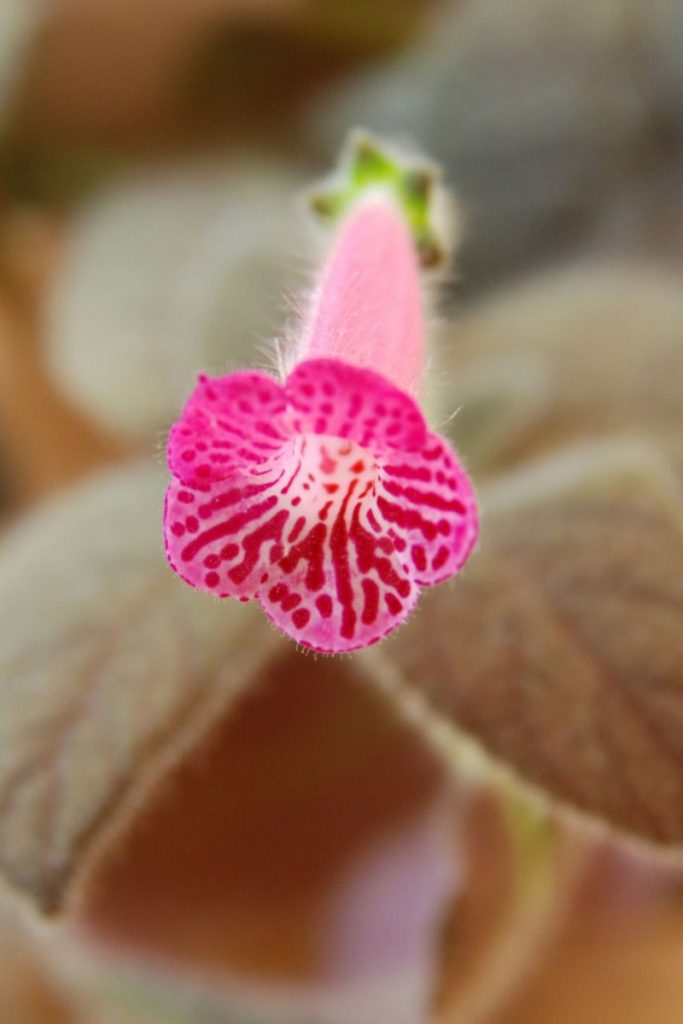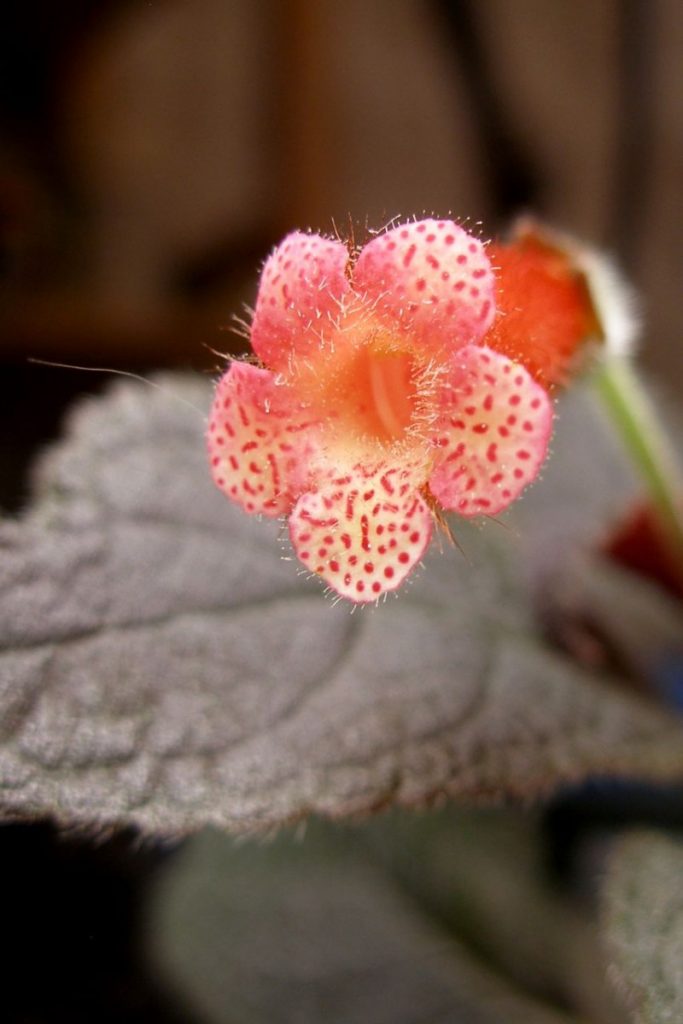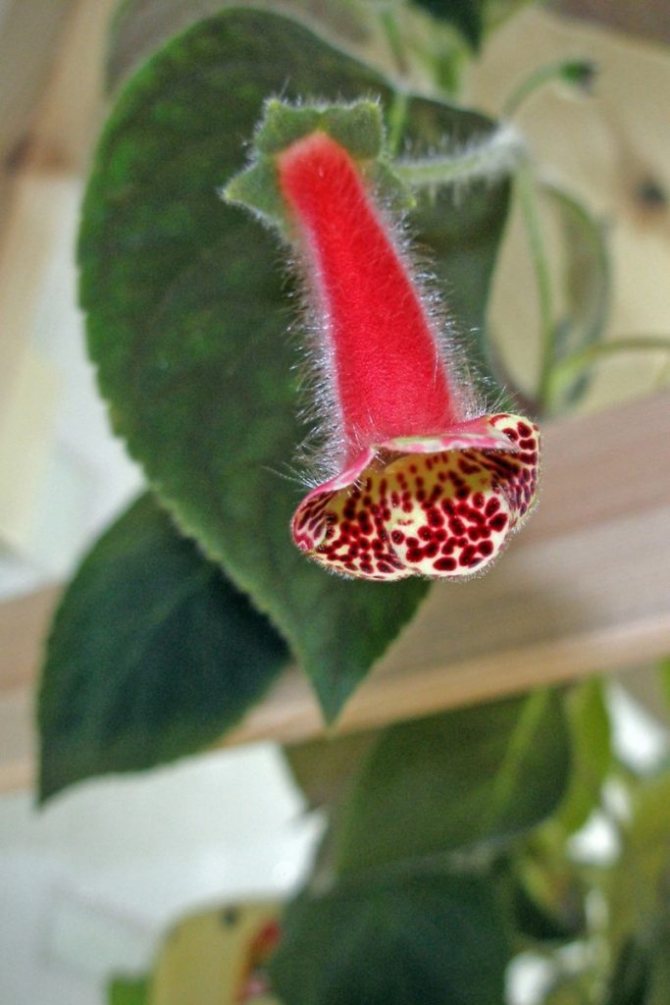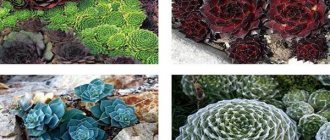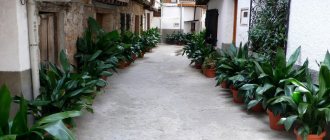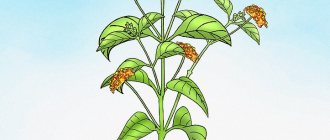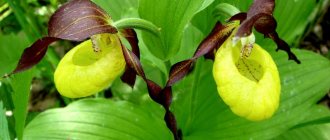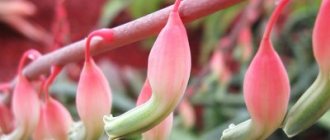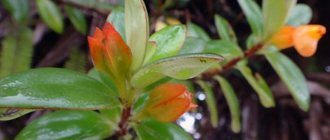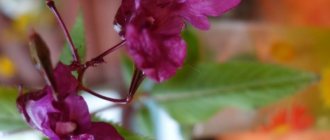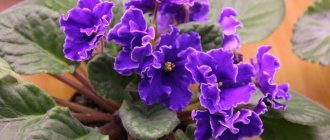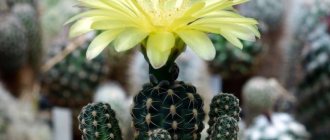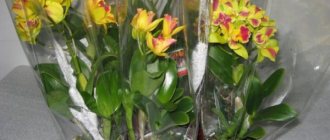Coleria flowers are representatives of perennial herbaceous plants. Although not very common among gardeners, it is relatively easy to grow. As a result, anyone can get beautiful inflorescences that will last for a long time.
Such a flower will be a great addition to the interior, especially considering its rarity. Red flowers are more common, rare species have pink, burgundy and orange flowers.
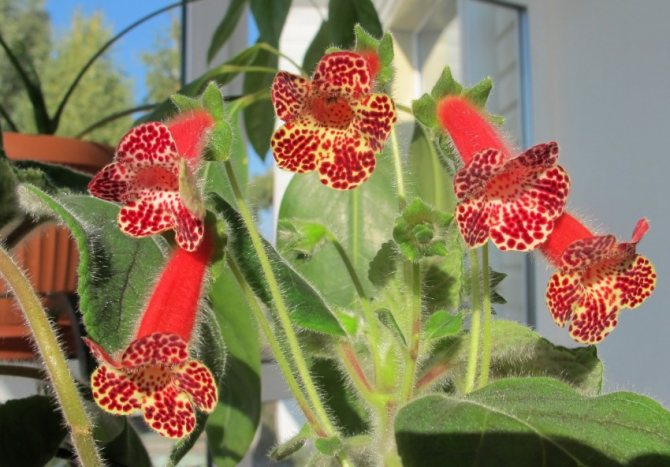
Array
Views from photo
The most common are the following types of koleria:
- Stunted (dwarf).
- Large-flowered.
- Foxglove.
- Nice one.
- Hairy.
- Fluffy.
- Bogotskaya.
Consider the features of each type separately, show a photo.
Stunted (dwarf)
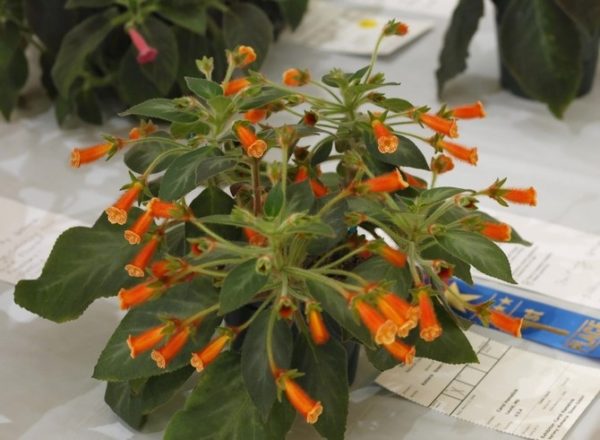

A stunted plant is the most beautiful miniature variety of coleria. Its height is no more than 30 cm. It has fluffy green leaves, on which stripes of light color are beautifully depicted. The flowering of the plant is abundant, and the flowers are bright, orange in color. It looks very impressive, as it resembles a bright hat in its appearance.
Large-flowered
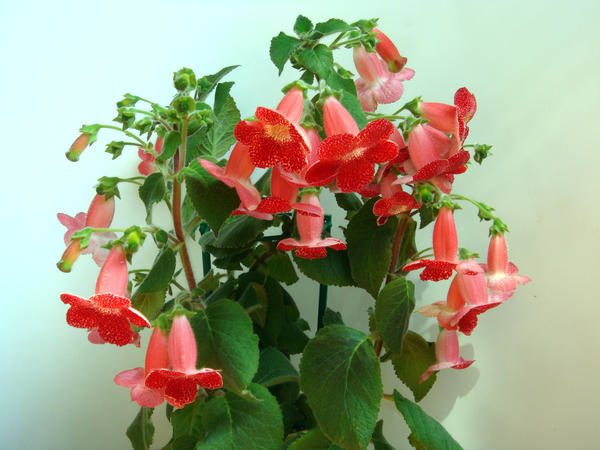

Shoots are often 60 cm tall, solitary and erect. Leaves are oval in shape, inside they have a reddish tint. The inflorescences are somewhat different in shape - they resemble a tube without expansion at the end. The colors are bright, often orange or red.
Foxglove


Pleasant color differs from foxglove in that it is lower, has wide leaves in the shape of an egg, as well as silvery veins of purple and other shades. Crimson blotches on the flowers give it a luxurious and original look.
Hairy
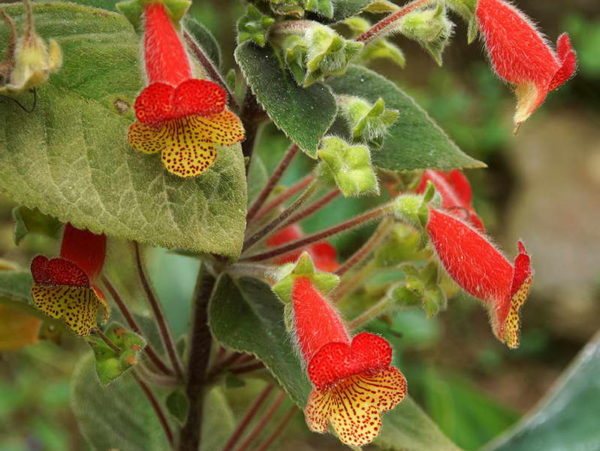

The hairy coleria is characterized by erect stems covered with fine white hairs. The leaves often have a noble bronze hue. Outside, the inflorescences are scarlet or lilac, on them there are many specks of burgundy color.
Fluffy
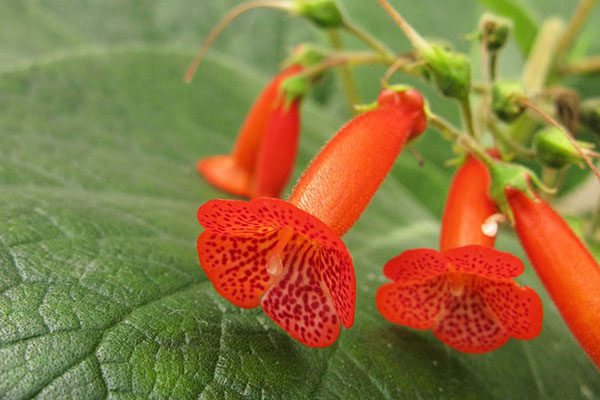

The presented variety is very similar to the foxglove color. It is characterized by green leaves, velvety to the touch and with red tints at the edges. The flowers reach 5 cm in length, they are orange-red and have yellow dots at the bottom. Fluffy color can reach 50 cm in height. This species is especially popular for home cultivation.
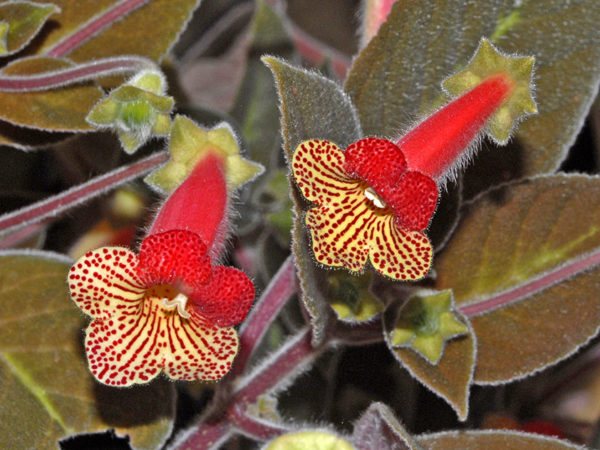

The Bogotá variety reaches 50-60 cm in height. In the wild, it is found in Colombia, as well as in rocky clearings in the forest. 10 cm leaves of light or dark color have a jagged edge. Coleria flowers are yellow-red on the outside and bright red on the inside. Flowering can continue throughout the summer.
The most beautiful and popular among gardeners are the following varieties:
- Flashdance.
- Jester.
- Karl Lindberg.
- Queen Victoria.
- Red Ryder.
- Roundelay.
- Srq s Persian carpet.
Let's talk about the features of each of the varieties further and show how the photo is, how they look.
Flashdance
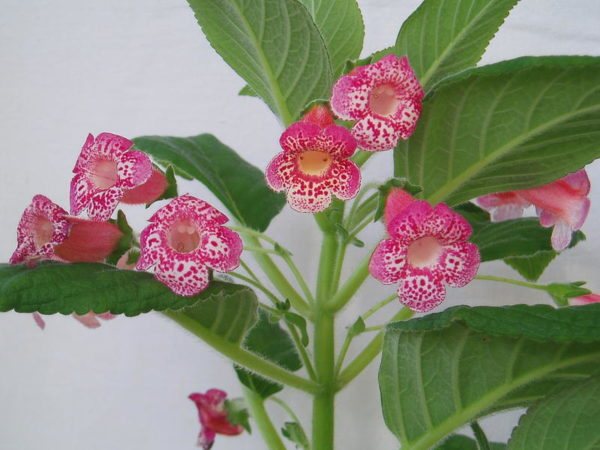

The presented variety was bred in Sweden in 2001. It is characterized by large yellowish flowers and pink petals. Raspberry stains distinguish this variety from others. There is also a dark fuchsia border around the edge of the petals. The foliage is green, not too light, but not dark either.
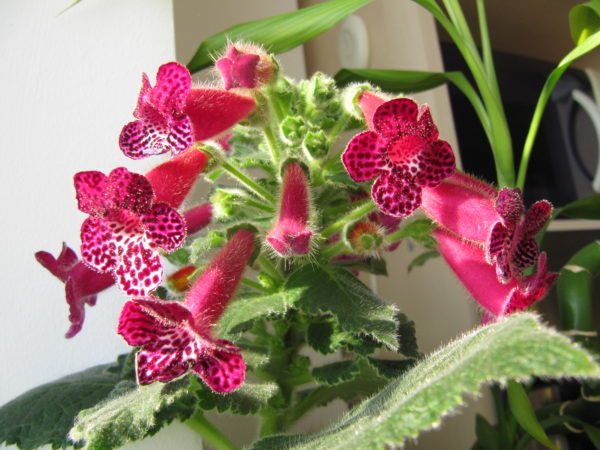

It was bred in 1982 by P. Worley.
On a straight stem, there are dense green leaves that go into a bronze tint. They bloom white at the base and have bell-shaped tubes. On the limbs, the petals are white, and beautiful pink spots can be seen in a thick spray.
Bright blooms are emphasized due to the fact that the spots merge into stripes, combining geometry and spontaneity in color. The foliage slopes down unhappily, and its edges have a jagged edge. The bush is small in size, but it blooms abundantly.
Karl Lindberg
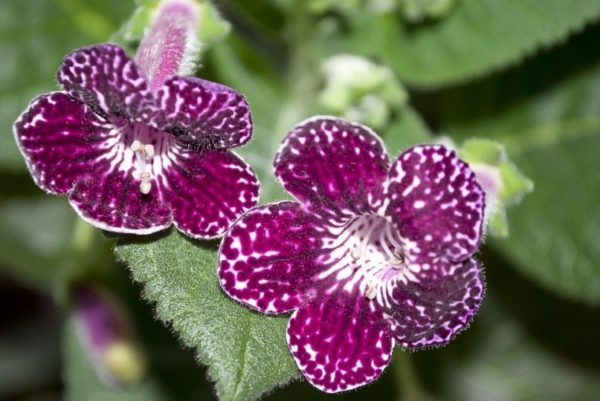

Karl Lindbergh is the darkest colored plant of all. Its tubes are painted in a dark lavender shade, and from a distance they seem to be velvety. Only white necks slightly shade them. There are petals on the limbs, dotted with beautiful small splashes of crimson hue. They thicken towards the base and form a horizontal line tube.
Queen victoria
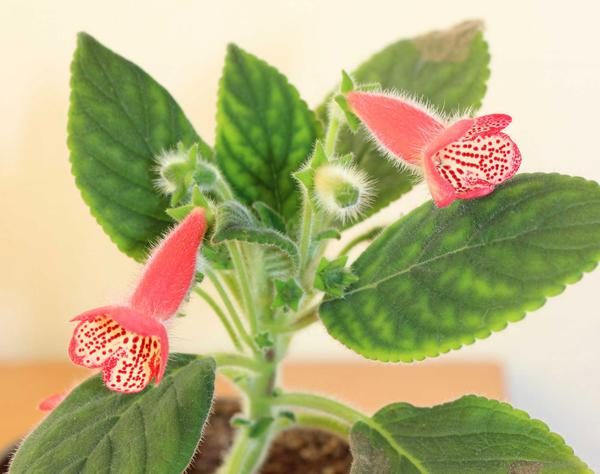

Queen Victoria is a unique koleria variety. Its flower arrangement is very delicate, it has beautiful pink flowers. A white neck against such a background looks especially impressive. The petals are also light with bright blotches of a beetroot shade. The leaves slope slightly downward, they are dark green in color.
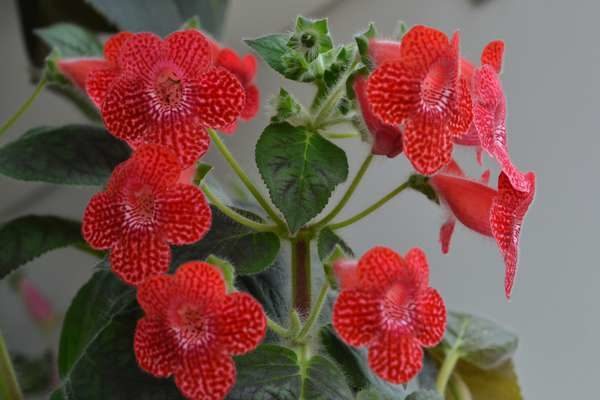

Red Ryder is a beautiful plant with dark red bells. The neck is white, just like the petals, dense rays of flowers of a dark cherry hue give this variety an originality. The leaves tend downward, they are thick and have a dark green tint.
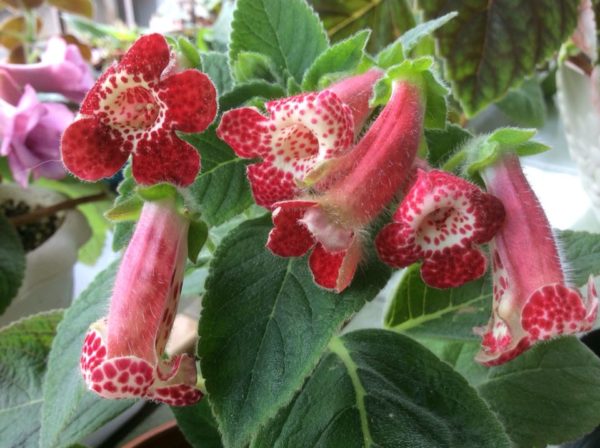

The presented variety of coleria is characterized by orange bells with a delicate white neck. The petals in the places of the folds are also whitewashed, they have rich pink splashes of various sizes and are framed with dark foliage. This plant is very bright, but, at the same time, compact.
Srg s Persian carpet
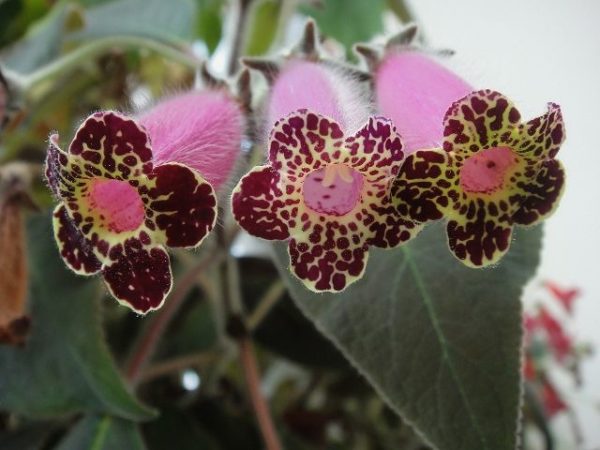

Srg s Persian carpet was created in 2013 by the breeder S. Saliba. The name "Persian carpet" exactly describes this kind of koleriya. Its flowers are velvety and have a rich hue. When you look at him, oriental motives can be traced. Large flowers of simple shape have a red-crimson tone and a delicate yellow neck.
Read also: Review of the IFH 1000 egg incubator
The yellow limbs of the petals are decorated with large cherry-colored peas, and the crimson edging gives them originality. The yellow halo has bright spots that look especially impressive under the open rays of the sun.
The leaves are serrated, they are green and have a red border, which complements the composition, making it more effective. The flowering is plentiful, and the bush is compact, it develops in the form of a lush cap.
Conditions
Fluffy coleria is perfect for warm rooms. In summer, for example, the maximum permissible temperature is 25 degrees. When flowering stops and a dormant period sets in, it is advisable to lower the temperature to 17 degrees. Also try to find a draft-free spot for the flower.
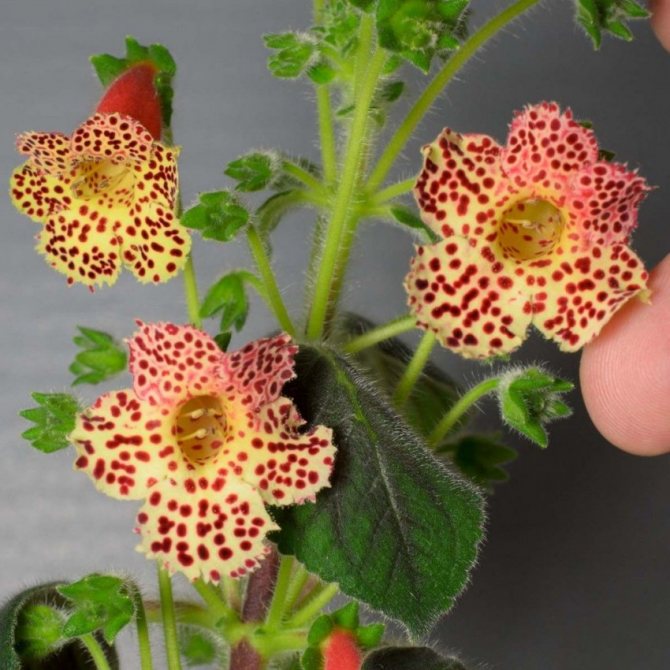

In the summer, you will need fertilizing with mineral or organic additives - all this is complemented by uniform watering.
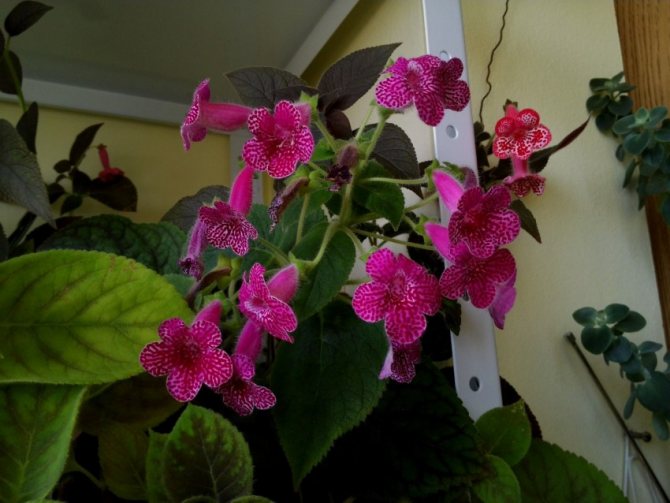

In the middle of autumn, the flower will finish flowering - less water is needed for watering. The dead aerial part can be moved to a cool place, at least 12 degrees.
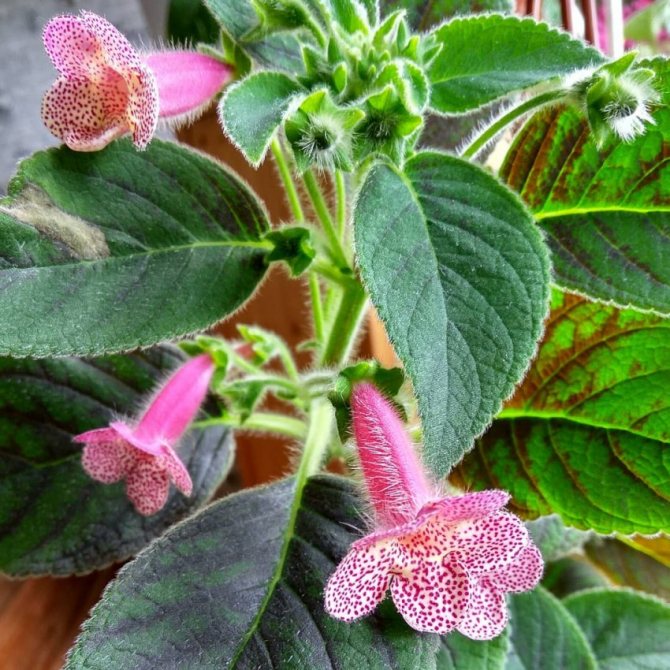

Appearance of koleria
Coleria leaves reach fifteen centimeters, up to eight centimeters wide. Outwardly, they look like oblong eggs. The edges of the leaves are crenate and have a fleecy surface.
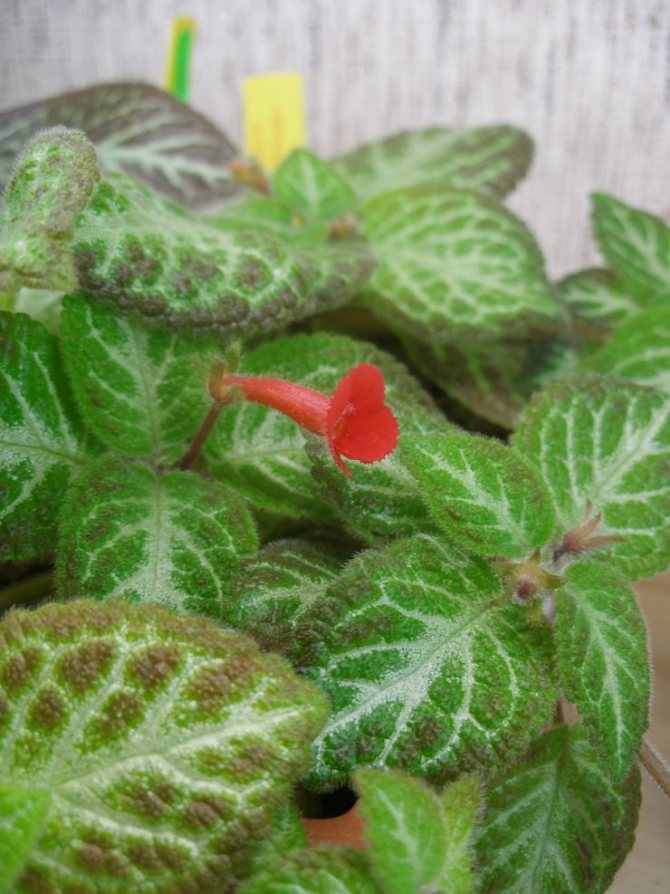

The color of the leaves is varied: from juicy dark green flowers to snow-white with pink pile. Some hybrids have acquired a silvery and bronze leaf color.
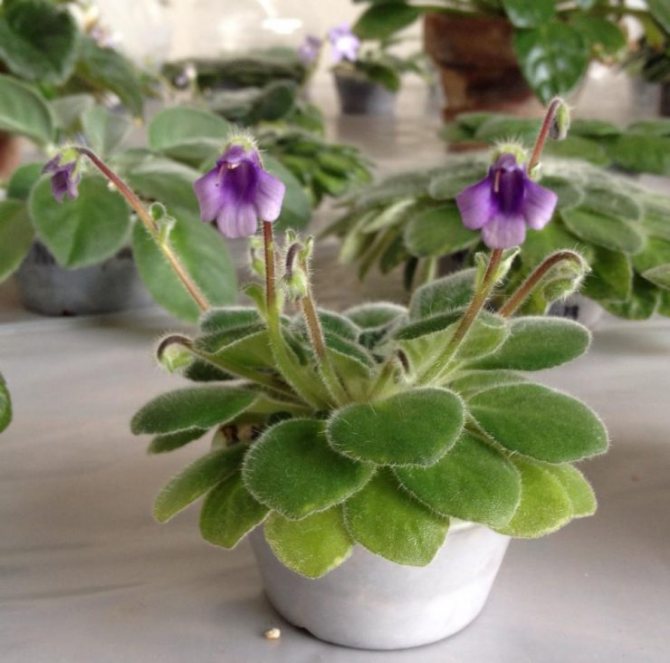

There are a lot of single flowers on the plant. Some varieties of coleria contain two or three flowers per peduncle.
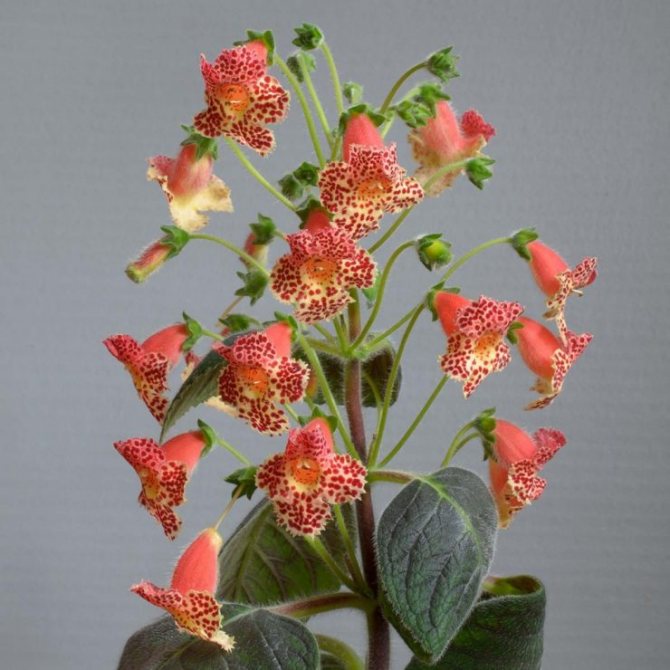

In appearance, koleriya flowers are similar to thimbles: wreaths with a small tube reaching five centimeters, narrow at the throat and swollen at the base. The color of the flowers is also varied: dark red with an orange throat, spotted corollas, etc.
Coleria are ideal for interior decoration; they take root most successfully in warm rooms. Florists have obtained a large number of koleriya hybrids by crossing with other plant species.
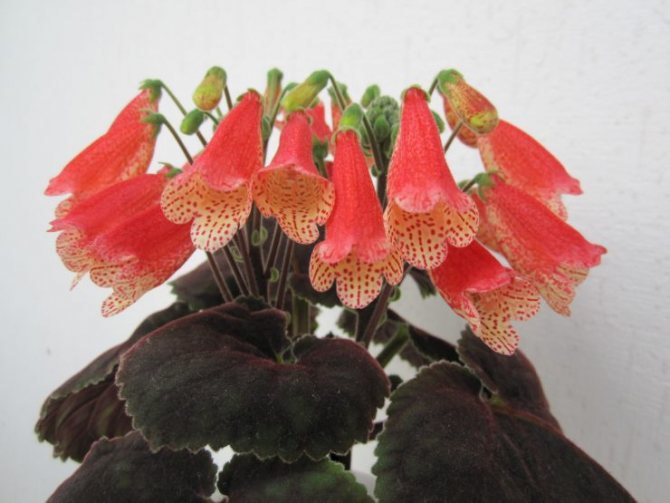

Thanks to this, the plants acquire an unusual color. Both standard forms of plants and miniature ones stand out, which will give an unusual look to the room. Photos of the collieria confirm this.
Shine
Also, it is worth taking care of sufficient lighting, without direct sunlight. Again, after the plant stops blooming, it should still be getting enough light.
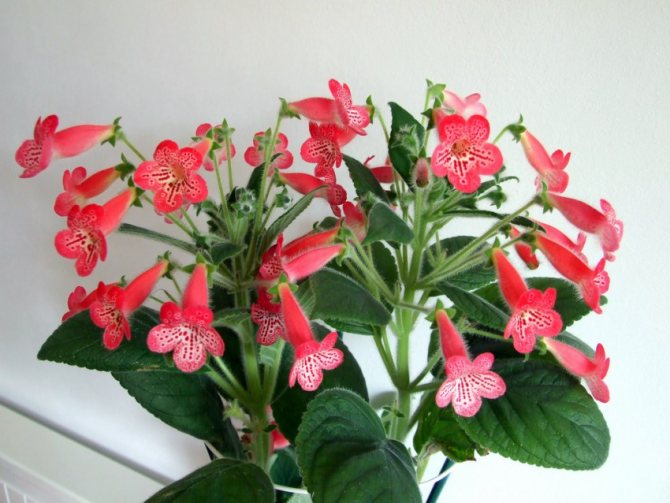

With the right approach to lighting, you will end up with bright and dense foliage. Therefore, try to select western or eastern windows. Photo of a collier will help you understand the change of periods in its life cycle.
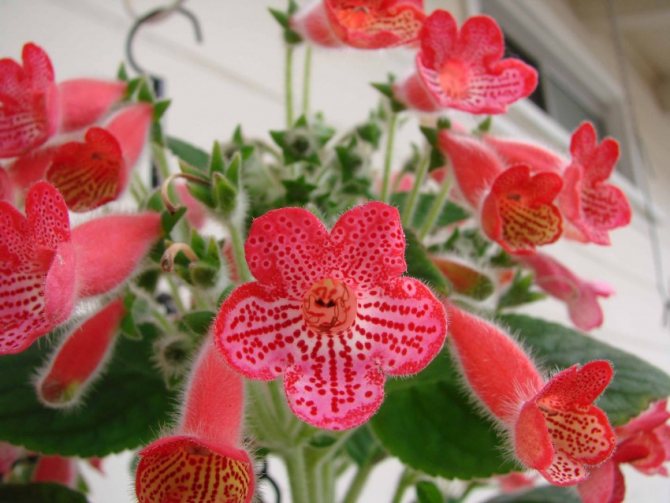

Description of the plant
Kaleria (koleria) belongs to the Gesnerian family, grows naturally in the tropics of equatorial America.
The leaves of the plant reach a length of 15 cm, their surface is covered with a small red or white pile. The color varies depending on the type of flower (there are olive, bronze, silvery, dark green leaves with light veins).
Abundant flowering is especially appreciated by flower growers who breed the plant. Bell-shaped flowers of various colors, usually with 5 petals, are arranged in 1-3 pieces. on the peduncle. The hybrids have cherry, amethyst and other interesting shades, but in nature this plant blooms with pink-white, red-orange, brown-white flowers. The petals are usually not monochromatic, but with a pattern - specks, strokes, stripes.
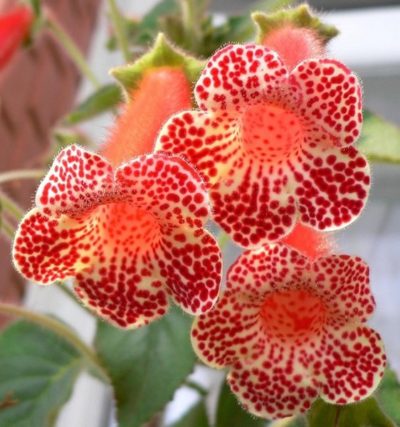

Kaleria flowers immediately attract attention
Kaleria is not picky about care, so it is not difficult to grow it at home.
Campanula is also distinguished by its unpretentiousness and abundant flowering. Read more about this plant in the material: https://enn.imadeself.com/rastenija/kampanula-uxod-za-izyashhnymi-kolokolchikami-v-domashnix-usloviyax.html
The main types of flower
- Fluffy. The plant is quite tall - up to 0.8 m in height, with green leaves covered with reddish pile. The bright red flowers with yellow dots on the petals are very spectacular.
- Digitalis. Flowers are bell-shaped with a wide limb. The whole plant is covered with white hairs.
- Nice one. Leaves are silvery green with purple streaks. The flowers are pink, small - about 2 cm.
Photo gallery: different calories
Bright red flowers are very spectacular Digitalis - one of the most popular types of kaleria Pleasant kaleria flowers - the smallest (about 2 cm)
Table: what conditions of detention are required depending on the season
| Season | Lighting | Humidity | Temperature |
| Autumn winter | Well lit place, shaded from direct sunlight. | Prefers moist air, although tolerates dry air well. You need to spray the air around the plant, since the fleecy leaves of the kaleria react unfavorably to the ingress of water droplets. Another way to provide the necessary moisture is to place the plant pot on a pallet of damp pebbles. | 20-24оС |
| Spring Summer | 17оС |
Moisture and liquid
The flower begins to grow in the spring and continues to bloom until autumn. At this time, it requires moderate watering - the soil should not be waterlogged or overdried. During the winter months, watering should be done even less frequently. Even if the plant is about, the rhizome still needs to be watered sometimes.
In terms of moisture, the color scheme is universal, home care is simplified at times. However, it feels better in humid climates.
When you create conditions of high humidity, be careful not to get water on the leaves - they cannot stand it. By the way, it is better to use warm water for watering.
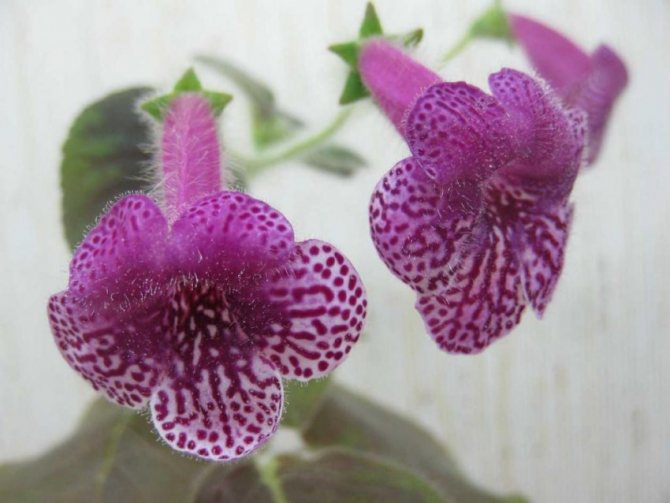

Coleria: a guide to care and watering. 86 photo decoration ideas
Coleria is a perennial plant. Quite easy to clean. Despite this, it has not become widespread. And in vain, since many flower growers celebrate the amazing beauty of the flowering of the plant.
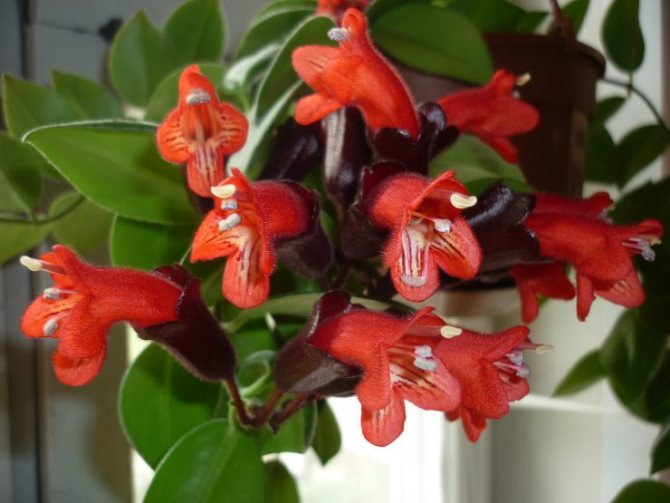

In addition, the flowering period of Coleria is very long, which allows you to enjoy the flowers of this plant for a long time.
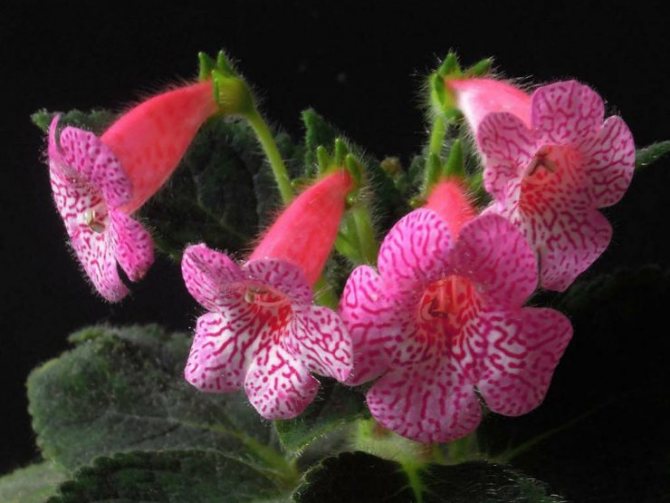

Coleria belongs to the Gesneriaceae family. It is an ornamental indoor plant. The birthplace of this plant is the tropics of America. They gained their mass distribution in the region of Mexico, Colombia and in the small island states of North and South America.
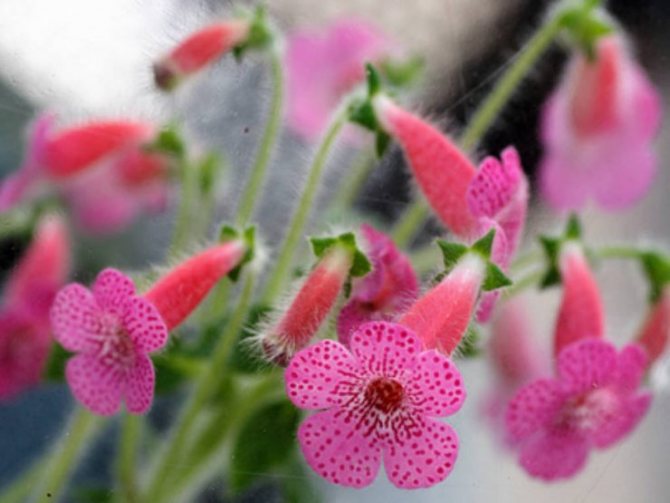

The plants owe their name to Michael Kohler, who was a science teacher in Switzerland in the early nineteenth century.
Reproduction
Reproduction of coleria is not difficult - for this, you can use several methods, such as dividing the rhizome, apical cuttings or seeds.
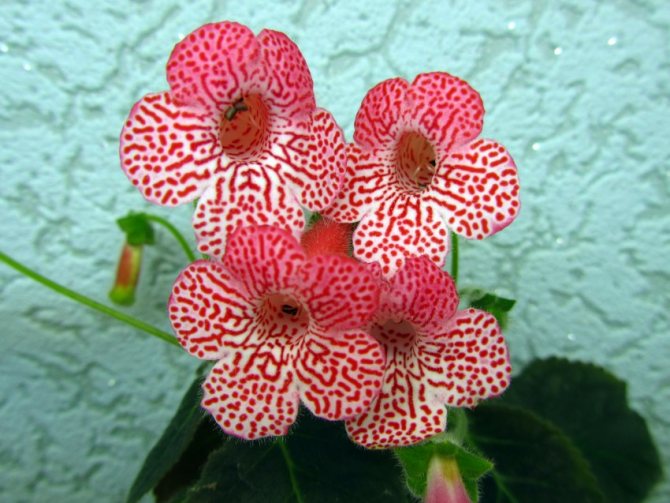

The easiest way, of course, is to divide the roots and root the cuttings, regardless of the season. The cut off top must be placed in water, and when it takes root a little, plant it in a shallow container. There is enough soil for the rhizome, where it sits down a few centimeters and is watered immediately.
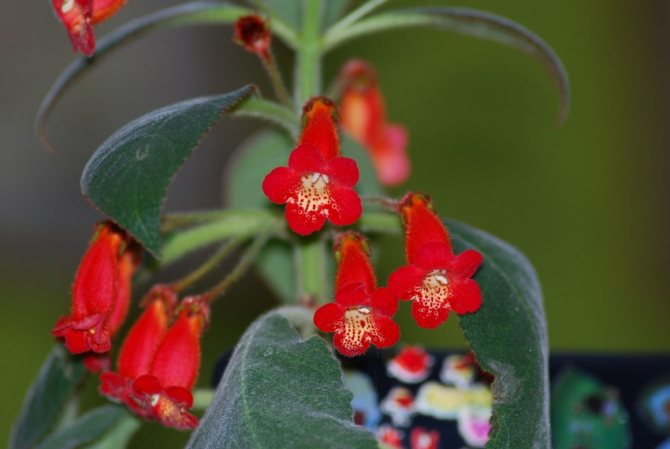

Color content temperature
Moderate temperature around 18-22 degrees and humid air from March to November. If the ground part dies off for the winter and only the rhizome remains, you need to leave it in the room at a temperature of 15 degrees and water it occasionally so that the root does not dry out. If the ground part remains green for the whole winter, in order for the flower to feel comfortable, it is necessary to leave it in the same room as in the summer, but lower the temperature slightly to 18 degrees.
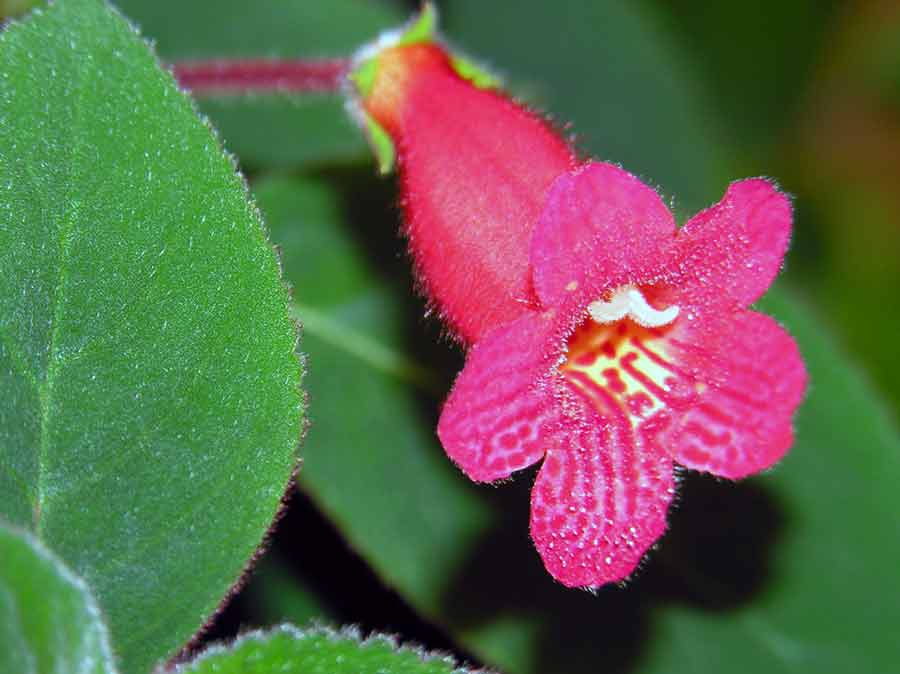

Koleria transplant
In the spring, annually it is necessary to transplant koleriya into new soil and, if necessary, a pot. During transplantation, the rhizome is examined, young shoots are planted so as not to crowd each other.
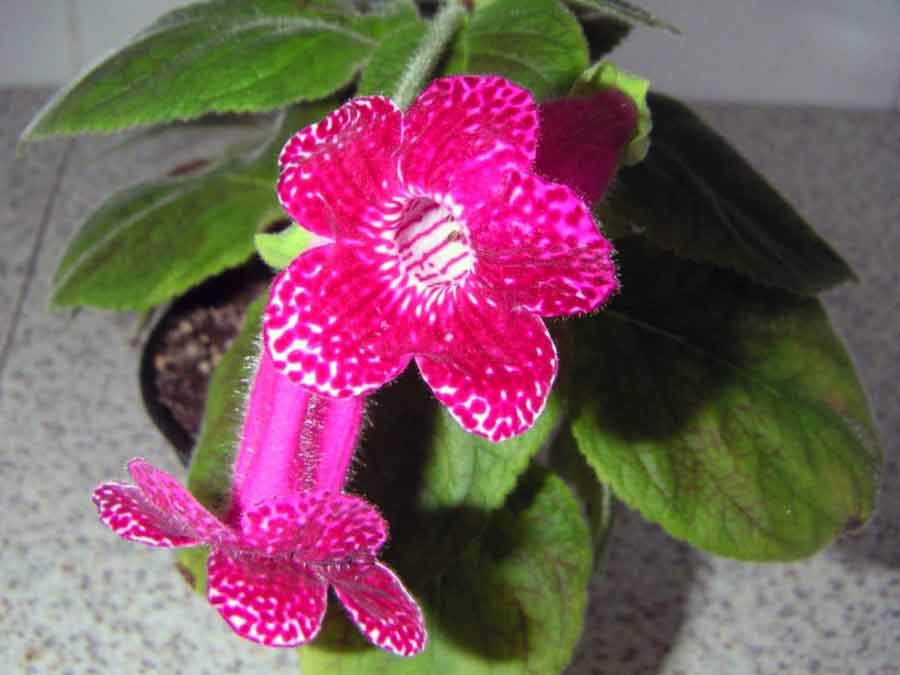

Top dressing is carried out in the spring and summer about once a month, it is important not to overdo it with solutions so as not to harm the plant. It is better to flavor less often, but for the benefit than often to the detriment.
Of the most common pests that threaten the plant, aphids and spider mites can be called. True, they rarely touch color. And yet, if necessary, you need to treat the plant with a fungicide.
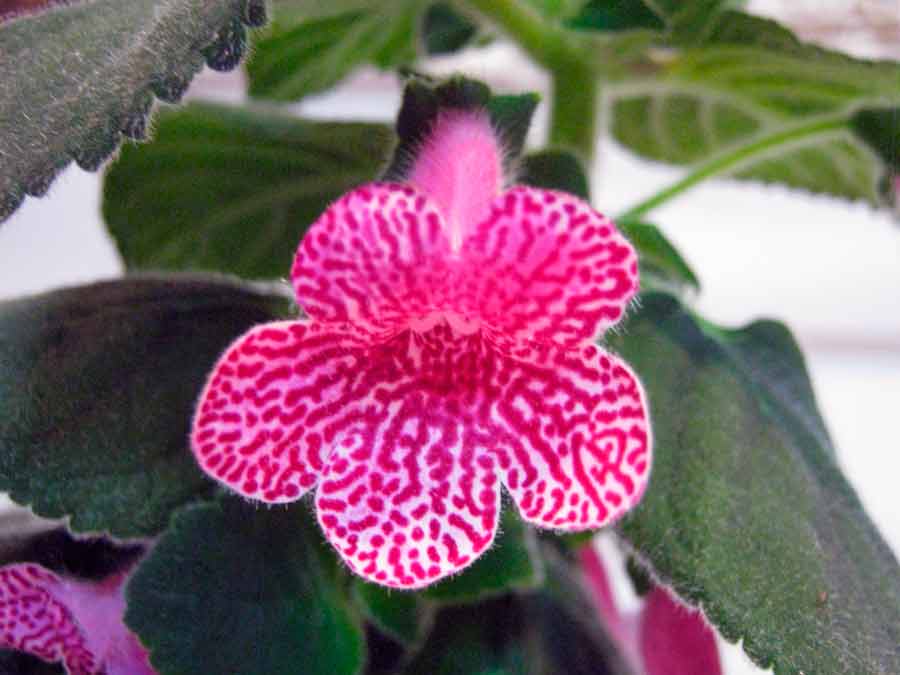

Landing koleria
To grow coleria, wide, shallow pots are used, since its rhizomes grow on the sides, and do not deepen.
The soil is best combined from peat and leafy soil, as well as sand. You can use ordinary, ready-made, purchased land, but it does not always suit this plant. Before use, it is better to treat the soil with a solution of potassium permanganate, in order to neutralize it from all kinds of harmful bacteria and pests. Drainage is mandatory for planting and transplanting in order to remove excess moisture, since due to abundant watering, rot may appear in the rhizome, and the plant will wither.
